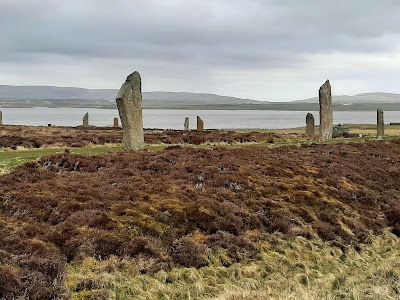 |
| June 18, 1941: Bren Carriers at Ring of Brodgar |
It seems inconceivable to us now...war games in the Neolithic ruins of the Ring of Brodgar. But the 9th (Donside) Battalion, Gordon Highlanders were maneuvering in Orkney--trying to close the training gap that saw Germany's experienced army seize most of Europe in the face of poorly trained opposing forces in the early days of World War Two.
.jpg) |
| April 21, 2022: Invergordon murals from the train |
On June 18, 1941 (when the photo of Bren Carriers was taken) a real war was underway. So an indulgence is merited in the protection of cultural heritage sites perhaps. It was the least of their troubles. And how much damage the site sustained is subject to dispute. Some of the tracks are still evident.
 |
| April 12, 2022: Neolithic Ring of Brodgar |
The Donside Battalion had sailed from Aberdeen for the Orkneys on September 2, 1940, the first year into the war. The British were certainly under duress, having to hastily develop defense lines and organize called-up divisions in anticipation of a full scale invasion. The 9th would garrison in defense of the Royal Navy base at Scapa Flow and Hatston Airfield about a mile northeast of Kirkwall--until October 11, 1941.
.jpg) |
| April 23, 2022: Invergordon murals from the train |
Then in October, the 9th Battalion redeployed, arriving first at Alnwick to join the 216th Independent Infantry Brigade, ultimately being destined for India in January 1942. On May 27th, 1942, it embarked from Glasgow, and was at-sea when it was re-designated the 116th Royal Armored Regiment, landing in Bombay July 27th, 1942. Thus began several years of hard fighting in the Burma theater.
On 14 August 1945, news was received that the war with Japan was over. Official surrender of Japanese forces, however, was not received until September 12, which meant the Gordon Highlanders would be the last armored regiment to come out of action. It was the last British armored unit to be engaged by enemy forces and, at the end of the war, the British regiment furthest from home.
 |
| April 12, 2022: Neolithic Ring of Brodgar |
The 9th Highland Division's motto, ‘Bydand,’ is a Scottish word
meaning ‘steadfast’. Additionally, the 9th Battalion held the motto: ‘Laro Aur Larte Raho’--meaning ‘To Strike And Strike Again’ in the Urdu language. (The 116th, armored with Shermans, was assigned to the 255th Indian Tank Brigade.)
Hatson airfield, incidentally, was the first with hard runways built in Britain, the first built on Mainland Orkney in the prelude to war and, given that construction began just prior to the war, it was also fully operational by the time war broke out in September 1939. The first aircraft to try out the tarmac landed on August 25, 1939--literally a matter of days before WWII began in earnest.
 |
| April 12, 2022: Neolithic Ring of Brodgar |
No comments:
Post a Comment